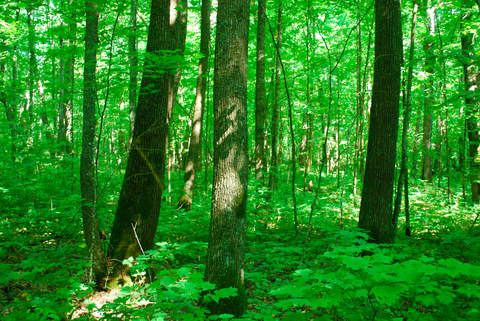Quick facts
- Sawlogs and veneer logs are the major wood products. Some species are also harvested for pulpwood.
- Growing conditions and regeneration methods vary by tree species.
- The best timber grows on moist, well-drained, fertile, loamy soil.
- Major pests include forest tent caterpillars, nectria canker, sapstreak of maple and heart rot.
The northern hardwoods forest type includes many tree species, which vary by site and geographic range.
Species may include sugar maple, American basswood, white ash, black ash, yellow birch, red maple and elms. Occasionally, aspen, paper birch, balsam fir and northern red oak are important. Beech and eastern hemlock range from Michigan eastward.
Sawlogs and veneer logs are the major wood products, but some species are also harvested for pulpwood. Maple syrup is made from sugar maple sap. Wildlife found in a northern hardwood forest may include deer, bear, squirrel, ruffed grouse and woodcock.
Growing conditions
- Very shade-tolerant: Sugar maple, beech, hemlock and balsam fir.
- Shade-tolerant: Basswood.
- Moderately shade-tolerant: Yellow birch, white ash, red maple and red oak.
- Shade-intolerant: Black ash, paper birch and aspen.
Elms, black ash, yellow birch, red maple, eastern hemlock and balsam fir survive best on high-moisture sites. Sugar maple, white ash, basswood and beech are generally confined to better-drained soils.
You will find the best timber on moist, well-drained, fertile, loamy soil. The poorest sites occur on soils that are infertile, dry, shallow or swampy.
Regenerating northern hardwoods
A wide range of systems can regenerate northern hardwoods, depending on the species you want to favor.
If you want high-quality, very shade-tolerant species (e.g., sugar maple, beech, hemlock and balsam fir), use single-tree selection or group selection methods.
Under this approach, you will select specific individual trees or groups of trees to harvest. After a selection harvest, the residual basal area (the sum of trees’ cross-sectional areas at breast height) should be approximately 80 square feet per acre.
If you want a stand with trees around the same age (known as an even-aged stand) dominated by sugar maple, use a two-cut shelterwood system. This system partially harvests trees so new stems can grow up under an overstory of maturing trees.
Start by harvesting in the winter, leaving 60 percent crown cover after the first harvest. Then, make the second cut after the seedlings in the understory (known as advance regeneration) are 2 to 4 feet high.
If you prefer a greater variety of species, use a two-cut shelterwood system.
- Harvest in any season except summer.
- Scarify the site during harvest.
- Leave 70 to 80 percent crown cover.
- Remove undesirable seed sources.
- Perform the second cut after advance regeneration and the seedlings in the understory are 2 to 4 feet high.
It’s rarely necessary to plant seedlings. But, it’s appropriate for open fields or under a shelterwood system, if you want to change the species composition. In open fields, only plant in fertile, well-drained soils.
Here are some guidelines for planting seedlings:
- Thoroughly disk the soil before planting.
- Plant tap-rooted species such as white ash and northern red oak.
- Plant only when there’s good soil moisture.
- Control weeds for one to three years after planting.
- Under shelterwoods, kill undesirable understory plants and plant in the most open areas immediately after site preparation.
If aspen is mixed with more shade-tolerant northern hardwood species, decide whether you want to encourage aspen or the other species.
If there’s an overstory of aspen and an understory of hardwoods, you can favor the aspen by clear-cutting the stand to stimulate root suckering. Favor hardwoods by removing the aspen when the understory hardwoods are 1 to 3 inches diameter at breast height (DBH), taking great care to avoid damaging the hardwoods. If the aspen has little commercial value, consider killing it with herbicides and letting it stand.
If aspen and other hardwoods are the same size, you can favor aspen by clear-cutting the stand. If aspen is scarce but desirable, follow the harvest with burning or shallow scarification to create an aspen seedbed. To encourage hardwoods, consider thinning or harvesting the stand.
Intermediate treatments
Remove poor-quality trees and undesirable species.
Pest management
Insect and disease pests vary due to the diverse species composition of the northern hardwoods forest type.
The most problems are caused by forest tent caterpillar and a fall defoliator complex (a mixture of up to 10 insect species). No cultural controls are available. Chemical insecticides like Bacillus thuringiensis (Bt) are effective.
Nectria canker can be common, especially in uneven-aged stands that include trees of various ages. To reduce damage, maintain healthy stands and remove infected stems.
Sapstreak of maple and heart rots are also serious. To minimize damage from these diseases, reduce damage to roots and stems. For example, use rubber-tired skidders during cutting operations and harvest during the winter or dry seasons. Remove diseased trees as soon as possible.
CAUTION: Mention of a pesticide or use of a pesticide label is for educational purposes only. Always follow the pesticide label directions attached to the pesticide container you are using. Remember, the label is the law.
Reviewed in 2019


